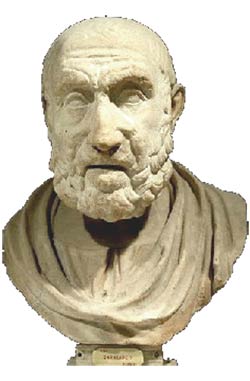Even the Eye Suffers from Rheumatism
by Renato Alberto Meduri
"Greeks were the first to make a distinction between the regular tears shedded by the eye and those expressing anxiety and pain."
In every organ and system there is a special type of tissue,
characterized as being connective, which carries out very important life
functions.
Just like our whole body, the connective tissues are subject to
the ageing process or diseases which include rheumatic diseases.
Since
connective tissues are mainly found in bones, articulations, and tendons,
rheumatism therefore affects this structure. Generically, we speak of arthrosis
when it is of the degenerative type or of arthritis when the main cause is an
injury with prevalent inflammatory and immunological responses.
Even the eye has connective tissues. The
sclera, the eye's external white shell, is connective tissue with few
vessels and nerves. Scleromalacia is the degenerative thinning of the sclera
occurring in adults and older persons causing atrophy and perforation of the
sclera visible as dark spots and jagged sides. Except in extreme situations, a
specific therapy is not required when there are no symptoms (visual problems and
pain).
Even the conjunctiva, the membrane that covers the external surface
of the eye, and the uvea, the
pigmented inside lining of the eye, are rich with connective tissues which can
be affected by rheumatic diseases. In these cases, the symptoms can be
the following: pain in the ocular globe more or less intense which sometimes can
be accentuated following prolonged visual application, redness of the eye
without secretion, visual loss, intolerance to light, characteristics of other
syndroms (lupus, scleromalacia, Wagner's disease, etc.).
In infants and
school-age children, recurring inflammation can result in the horizontal
band-shaped opacification of the cornea
beginning on the periphery, but in more advanced cases affecting the central
portion of the eye which causes important visual
loss.
The
manifestation of pathologies of connective tissues can even involve selectively
at times the glandular system responsible for the lubrification of the eyeball's
surface and the production of tears.
In its lighter forms, they can cause
simple eye dryness with difficulties to open eyelids upon awakening, feeling of
heaviness at night, pronounced sensitivity to irritating agents and a general
sense of discomfort. The more serious forms can lead to painful cornea with
formation of small areas of mucosal epithelium, areas of thickening of the
conjunctiva, a severe sense of discomfort and intolerance to light. The most
common syndrome is that of Sjögren. It affects the immune system, targets
moisture-producing glands and causes dryness in the mouth and eyes. The association between arthritis
and this syndrome was first documented in 1889 by Fisher, but way before that
Hippocrates (460 B.C. - 370 A.C.), physician known as the father of medicine,
had associated arthritis and lumbago with the dry eye.
Therefore, the importance of tears had already been well understood in
ancient Greece; they were gathered in small phials and given an emotional
meaning. Greeks first subdivided tears in two typologies: those
characteristic to the eye (basic
secretion) and those expressing anxiety and pain (main lachrymal
gland).
It is a very
important chapter for the eye specialist, whether it is for the
importance of its effect or the new knowledge which are emerging
from numerous experimental and clinical studies outlining the possibility of
therapeutic strategies that are more selective and effective.